Lenten Weekly Meditations
Lenten Weekly Meditations
– Sister M. Jean Frisk, S.S.M.
The following five meditations take their orientation from the Sunday liturgies for Lent, from the five votive Masses in honor of Mary for the Lenten season, from Sacred Scripture, and from the devotional traditions that have evolved over the centuries which link Mary to the Passion, Death and Resurrection of Our Lord Jesus Christ.
"and his mother kept all these things in her heart." (Luke 2:51b)
Week 1
Week 2
Week 3
Week 4
Week 5
Week 1
Follow Christ
Liturgical Readings of the Season
The Roman Catholic Church presents two covenant themes in its choice of Old Testament readings for the first two Sundays of Lent. The first is the story of Noah, "See I establish my Covenant with you, and with your descendants after you; also with every living creature to be found with you." (Genesis 9:8-9)
Noah believed God! He believed in the face of mockery, and in his belief he acted. His belief was not a passive waiting and a silent endurance. Instead, Noah built as he was instructed to do, and he activated his entire family to cooperate in this faith project.
The second Sunday of Lent tells the story of Abraham's great faith. His life had been one great journey of faith, but there was still one act of total abandonment asked of him for the sake of God's kingdom. Abraham was asked to surrender the child of the promise, the child whom he loved more than his own life. Abraham trusted. Abraham believed.
Because you have done this, because you have not refused me your son, your only son, I will shower blessings on you. (Genesis 22:17)
Abraham's faith also established an unbreakable covenant with God. Noah and his family, Abraham and Sarah believed in God, trusted God and proved their love for God by their day to day actions. The liturgy uses the stories of the Sacred Scriptures to tell us of the marvelous things God did in the past with those whom God chose, but the purpose of the liturgy is on-going, forever fresh. We are to be covenant keepers and followers in our time, as they were in their time. As the Psalms of these two liturgies tell us:
All Yahweh's paths are love and truth for those who keep his covenant and his decrees. (Psalm 25:10)
The close secret of Yahweh belongs to them who fear him, his covenant also to bring them knowledge. (Psalm 25:14)
Those who keep God's covenant and follow him will learn the knowledge of love and truth. The singer of the Psalm begs God:
Relieve the distress of my heart, free me from my sufferings. (Psalm 25:17)
Let innocence and integrity be my protection, since my hope is in you, Yahweh. (Psalm 25:21)
In the readings, we are led closer to Jesus Christ who is the answer to Noah, who teaches us active patience in our waiting for redemption. (1 Peter 18:22) Jesus is the Son who will be offered once and for all. Jesus is the Son that will be offered as the Lamb of sacrifice.
God did not spare his own Son, but gave him up to benefit us all ... Could anyone accuse those that God has chosen? ... Nothing therefore can come between us and the love of Christ, even if we are troubled and worried... (Romans 8:31b-35)
Jesus Christ is the one like us in all things; he underwent temptation and lived the human life in all things except sin. (Mark 1:12-15) He is the Son, the Beloved, to whom we are to listen. (Mark 9:2-10)
The liturgy for the second Lenten Sunday gives yet another text for us to ponder:
Yahweh, I am your servant, your servant, son of a pious mother, you undo my fetters. (Psalm 116:16)
We do not know who the song writer is nor who his pious mother is, but our liturgical sense will link these texts to Jesus, and we may draw his mother into our reflections as well. We may ponder the Sacred Texts with Mary, as she surely did as a faithful daughter of Sion. In her sorrow at his passion and death, she may have found comfort in the Psalm that the liturgy applies to her beloved Son:
Return to your resting place, my soul, Yahweh has treated you kindly. He has rescued me from death. My eyes from tears and my feet from stumbling. (Psalm 116:7)
Follow Christ with Mary
Liturgical Readings of the Season from the Votive Mass of the Lenten Season: Holy Mary, Disciple of the Lord
For special occasions, such as pilgrimages to a Marian shrine or extraordinary events for Marian groups, the Church provides votive Masses with a Lenten theme. The first of the five Marian Lenten Masses ties in with the liturgies for the universal Church in the theme of the innocent young heart who rejoices in her heart because the "precepts of the Lord are right." (Sirach 51:13; Psalm 19:9)
Mary is presented to the Church as the woman who has faithfully sought wisdom. She is the one who believed the word of God, who found the Lord trustworthy, "giving wisdom to the simple." (Psalm 19:8) She is the Virgin who kept the word of God and pondered it in her heart.(See Luke 2:19) She followed the Lord from the first moment of his earthly existence, and heard the words praising her for her faith:
Yes, blessed is she who believed that the promise made her by the Lord would be fulfilled. (Luke 1:45)
The votive liturgy applies a text from the book of Sirach to Mary. Mary has sought wisdom, that is, she has searched for her God and found him who is the truth, the way, the life. Because she sought wisdom and found it, she herself is gifted with wisdom, the wisdom that sings God's praises, as Mary did in her Magnificat song. Read the holy words of Sirach:
When I was young and innocent,
I sought wisdom.
She came to me in her beauty,
and until the end I will cultivate her.
As the blossoms yielded to ripening grapes,
the heart's joy,
my feet kept to the level path
because from earliest youth I was familiar with her.
In the short time I paid heed,
I met with great instruction.
Since in this way I have profited,
I will give my teacher grateful praise.
... My whole being was stirred as I learned about her;
therefore I have made her my prize possession.
The Lord has granted me my lips as a reward,
and my tongue will declare his praises. (Sirach 51:13-18, 20-22)
Mary was filled with joy at the Annunciation and at the Visitation. The Nativity, too, had its moments of joy, but also its sorrow. But it was when Jesus was presented in the temple that she heard the prophecy:
"And a sword will pierce your own soul too -- so that the secret thoughts of many may be laid bare." (Luke 2:35)
From that moment on, Mary pondered on the saving mission of her Son with the knowledge that she, too, must suffer with him and for him. This she faithfully did to the very last.
Devotions Draw Us into Participation in Christ's Suffering
Over the centuries, Christians pondered the Gospel word concerning the sword that must pierce Mary's soul. Earlier translations often used the word "heart" since the heart was considered the place of love and pain, the place of intense feeling. In time, literature and art began to depict not only the sufferings of Christ, but also Mary's share in them.
Though the cross has been the consistent symbol of Christ's sufferings since the time Christianity came out of the underground in the fourth century, by the ninth century, other symbols were used in sculpture, glass and iconography to represent the sufferings of Jesus Christ. These symbols came to be known as the Arma Christi, meaning:
"all Christ's sufferings;
they were for him the weapons (arms)
with which he conquered death and Satan.
They are visualized through the
instruments which caused him suffering." (Schiller 198)
The weapons were also the insignia of triumph and majesty. The cross, lance, and vinegar sponge were solemnly carried by angels to accompany the resurrected Judge of the World. The earliest known of these representations is dated at 980. The judgment portals of the great medieval cathedrals often represent Mary and John interceding at the judgment of Christ; the instruments of the crucifixion are represented as symbols of victory in these scenes.
In the late Middle Ages, the passion relics from the crusades added the hammer, pliers, the lantern of the capture of Jesus, the iron handcuffs of the scourging, the pillar, the crown of thorns, the blaring trumpet deafening Christ on the way to the crucifixion -- all of Christ's five senses suffered. The greater the number of instruments represented, the greater the notion of suffering increased, a suffering that embraced the totality of an all-encompassing physical and spiritual suffering. The kiss of Judas, the denial of Peter -- each had their place.
But for Jesus, there is a pain most bitter: It is his knowledge of his mother's suffering for him and with him. This pain is indescribable anguish. The triumph of the Arma Christi takes on a different meaning in this light, and it is coupled with the suffering experienced in the Body of Christ through the devastation of the plagues of the late Middle Ages. It is during this time that devotion to Mary's sorrows begins to appear.
The Dictionary of Mary states: "It is probable that Blessed Henry Suso (1295- or 1300-1366) and other "Rhenish mystics" of the Dominican Order were a contributing factor." The Servite Fathers also developed devotions to Mary's five joys, then to her five sorrows. The numeration varies from five, to seven, to thirteen, and many others.
In 1482, John de Coudenberghe, a parish priest from Flanders, taught the Seven Sorrows as we know them today:
• The Prophecy of Simeon (Luke 2:34-35)
• The Flight into Egypt (Matthew 2:13-21)
• The Loss of Jesus for Three Days (Luke 2:41-50)
• The Ascent to Calvary (John 19:17)
• The Crucifixion and Death of Jesus (John 19:18-30)
• Jesus Taken Down from the Cross (John 19:39-40)
• Jesus Laid in the Tomb (John 19:40-42)
After the late Middle Ages, not many representations show Mary with a great number of passion instruments. Mary is more frequently shown contemplating one instrument or weapon, such as the crown of thorns. The experience of sharing has now become the experience of identification. Mary's sufferings are an important participation in redemption. She receives the honor of being a co-redemptrix. Hers is the subjective answer, the personal yes, to the objective redemption of the one and only Savior Jesus Christ.
During the baroque period in post-reformation Europe, especially in Italy and Spain, the devotion of the sorrows and the Arma Christi blended into the devotion of the pierced heart of Mary. This devotion became especially loved in the eighteenth and nineteenth centuries. Mary is often clothed in luxurious clothing with the dagger piercing her heart. It symbolizes the truth that suffering is spared no one, not the immaculately conceived Mary with all her dignity and blessedness from God, not the kings and queens with all their riches.
We illustrate here one devotional image of the pierced heart of Mary:
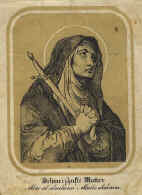 German Block Print
German Block Print
Prayer
This image is a nineteenth-century devotional image of Our Lady of Sorrows. The heart and the thorns are symbols removed from Mary directly. However, she contemplates deep within her own soul those inscrutable mysteries.
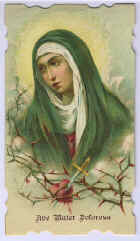
There is a prayer that expresses well the devotion to Mary's broken heart. It is part of the Stabat Mater, a hymn known in English as At the Cross Her Station Keeping, and attributed most frequently to Jacopone di Todi (d. 1306). The many stanzas were incorporated into the Liturgy as a sequence for the Mass of the Seven Sorrows celebrated on September 15. It is also the hymn for the Office of Readings, Morning and Evening Prayer in the Liturgy of the Hours. Formerly, several religious communities prayed this stanza several times a day each Friday.
Holy Mother, pierce me through
In my heart each wound renew
of my Savior crucified.
"And a sword will pierce your own soul too --
so that the secret thoughts of many may be laid bare." (Luke 2:35)
 Contemporary devotional image of Mary contemplating the cross and the cross of thorns. The Savior's blood flows through Mary's sorrows to the world.
Contemporary devotional image of Mary contemplating the cross and the cross of thorns. The Savior's blood flows through Mary's sorrows to the world.
Resources: Dictionary of Mary Catholic Book Publishing, 1998; Marienlexikon Eos Verlag, Vols 2, 6, 1988-1994.
Week 2
"As for Mary, she treasured all these things and pondered them in her heart." (Luke 2:19)
"He went down with them and came to Nazareth and lived under their authority. His mother stored up all these things in her heart." (Luke 2:51-52)
Follow Christ to the Foot of the Cross
Liturgical Readings of the Season
The Roman Catholic Lenten liturgy for March 2 presents a reflection on the laws of the covenant between God and his people. (See Exodus 19:5; 20:1-17) God revealed to Moses the conditions that would secure a blessing for the nation. Yahweh gave the Decalogue to the people through Moses:
"...I show kindness to thousands of those who love me and keep my commandments." (Exodus 20:6)
The powerful message of the Ten Commandments also warns us that God is a jealous God who will punish us for generations if the terms of the covenant are not kept. (See Exodus 20:5) Does the Gospel writer think Mary has remembered these covenant promises when she sings her Magnificat? All generations will call her blessed! The Almighty has shown his kindness to her. "He has routed the proud of heart." (Luke 1:51) It is not for us to know fully the connections Mary makes between her love for the law and the Lawgiver. Her song of praise does, however, give us these hints.
When we participate in the liturgy, we relate the readings to our own experience. Just as we may apply the readings to ourselves, we may also reflect on what may have moved Mary's heart when she learned the Ten Commandments of the Exodus narration. For certain, we know that it was characteristic of Mary to ponder, to treasure, to think, to store the meanings of things in her heart.
"As for Mary, she treasured all these things and pondered them in her heart." (Luke 2:19)
His mother stored up all these things in her heart." (Luke 2:52)
Did she know and sing the Psalms? Did she teach them to her infant son and growing boy? Probably! What would have been Mary's reaction to this week's liturgical choice?
If you live in the shelter of Elyon
and make your home in the shadow of Shaddai,
you can say to Yahweh, "My refuge, my fortress,
my God in whom I trust!"
You need not fear the terrors of night,
the arrow that flies in the daytime,
the plague that stalks in the dark,
the scourge that wreaks havoc in broad daylight.
"I rescue all who cling to me,
I protect whoever knows my name,
I answer everyone who invokes me,
I am with them when they are in trouble;
I bring them safety and honour.
I give them life, long and full,
and show them how I can save." (Psalm 91: 1-2;5-6;14-16)
When Mary gave her yes to God, she did not know where it would lead. She had to search continually for God's intention, just as we do. In this week's New Testament readings, we are given the passages from I Corinthians 22-25. The writer tells us about the madness and the obstacle of the crucified Christ. Just prior to these statements, there are passages in I Corinthians that invite further reflection:
Where are any of our thinkers today? Do you see now how God has shown up the foolishness of human wisdom? If it was God's wisdom that human wisdom should not know God, it was because God wanted to save those who have faith through the foolishness of the message that we preach.
Last week's Lenten meditation reflected on the faith of Mary, faith as we have it in the Pauline text above. It is a faith that sees beyond the madness and the obstacle of the suffering of Christ. Mary believed God! She believed the messenger of God. In contrast to last week's discussion, this week, we look beyond belief to pondering, to thinking about reasons, and about making connections to our contemporary situation.
The final reading for the Sunday liturgy is the story of Jesus' radical attempt to set the priorities of the temple staff straight. Jesus strews the hard-earned profits on the floor, he throws over tables; he shows zeal for his "Father's house"-- it is not to become a market place. (John 2:13-17) When he is asked to justify his actions, he uses the strange language about destroying the sanctuary and raising it up again in three days. (See John 2:18-22)
But he was speaking of the sanctuary that was his body, and when Jesus rose from the dead, his disciples remembered that he had said this, and they believed the scripture and the words he had said.
The disciples remembered! They believed the scriptures! They believed him! But their belief was strengthened and confirmed after Christ's resurrection. First, they would have to experience the great time of trial and the death of their Lord. The Sacred Scriptures praise Mary for her belief in Jesus Christ from the moment of his conception onward. She believed even as she stood at the cross.
Follow Christ with Mary to the Foot of the Cross
Liturgical Readings of the Season from the Votive Mass of the Lenten Season: The Blessed Virgin Mary at the Foot of the Cross
The special Collection of Masses of the Blessed Virgin Mary has two liturgies listed under the theme, The Blessed Virgin Mary at the Foot of the Cross. This meditation includes only the first selection. We pray in the opening prayer:
Lord our God,
in your mysterious wisdom
you fill out the passion of Christ
through the suffering that his members endure
in the many trials of this life.
As you chose to have the mournful mother
stand by your Son in his agony on the cross,
grant that we too may bring love and comfort
to our brothers and sisters in distress.
Standing by the cross of Jesus were his mother
and his mother's sister, Mary the wife of Clopas,
and Mary of Magdala. (John 19:25)
Mary was prepared for this moment through her life-long attitude of listening, pondering faith. She heard the word of God and kept it. This reflective pondering was prayer in its deepest sense. The Church has honored Mary's pondering and her intimate connection to the sufferings of Christ. Words from Scripture are reflected in symbols such as this image to our right.
She is the strong woman who stood. The Gospel explicitly uses the word "to stand." Even though her heart was broken, she remained open, reflective, listening for the message of God in the moment of profound sorrow.
The preface of the Marian Mass prays to our God:
In your loving providence
you decreed that Mary, the mother of your Son,
should stand faithfully beside his cross,
and so fulfill in her person
the prophecies of old,
and enrich the world
with her own witness of living faith.
Devotions Draw Us into Participation in Christ's Suffering
The Roman Catholic Church has used the rosary for nearly six centuries to contemplate the sufferings of Christ in and with Mary. Pope Paul VI called the rosary a "compendium of the entire Gospel," a prayer "centered on the redemptive Incarnation," in which "the litany-like succession of Hail Mary's becomes an unceasing praise of Christ." (Marialis Cultus 46) As the Dictionary of Mary states, "To pray the rosary is to contemplate with Mary the Lord made flesh, crucified, and raised for our salvation." (p. 296) In drawing our connection to the Sacred Texts used above, we recommend the rosary as a form of contemplative pondering, a time to think about the mysteries represented there, and to simply savor the opportunity to rest peacefully as we view the sorrows of Christ through Mary's eyes.
It was Alain of Roche, a Dominican preacher at Douai in 1464, who first taught the structure of the prayer as we know it today. We leave aside the joyful and glorious mysteries and list the five known as the Sorrowful Mysteries of the Rosary:
The Agony in the Garden (Mark 14:35)
The Scourging at the Pillar (Mark 15:15)
The Crowning with Thorns (Mark 15:17)
The Carrying of the Cross (John 19:17)
The Crucifixion (Luke 23:33)
Reflections on the sufferings of Jesus in written form and in art becomes increasingly evident in the literature, art and devotions of the later Middle Ages. Heinrich Seuse wrote about the painful experiences of the Sorrowful Mother. For him, it was only possible to contemplate Mary's share in Christ's suffering as an incomparable experience of human sorrow. Hildegard of Bingen spoke of the utter wretchedness of Mary's, and hence of the human condition. Mechthild of Mageburg describes the life-giving strength of the suffering under the cross. No suffering is its equal.
In art, the quiet interaction between an image and its beholder does perhaps more than words are capable of doing to express the intensity of this suffering. The remainder of this Lenten reflection will stop with its words and give the viewer images for contemplation.
Prayer
The Agony in the Garden (Mark 14:35)
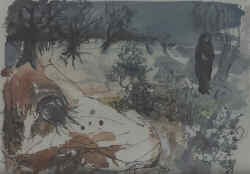 Agony in the Garden, Roxolana Luchakowski Armstrong, Contemporary Watercolor
Agony in the Garden, Roxolana Luchakowski Armstrong, Contemporary Watercolor
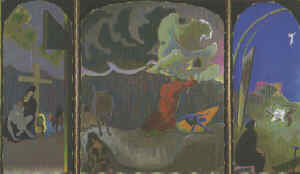 The Abandoned Boy, Patrick Pye
The Abandoned Boy, Patrick Pye
The central panel of the triptych depicts Abraham's challenge of faith; the left panel images the abandonment at the Crucifixion; the right panel shows the victory of Resurrection
 Mater Dolorosa, Mary Whelan, Contemporary
Mater Dolorosa, Mary Whelan, Contemporary
 Our Lady of Sorrows
Our Lady of Sorrows
This contemporary interpretation was drawn by a Crosier Brother of the Crosier monastery in Hastings, Nebraska.
The Scourging at the Pillar (Mark 15:15)
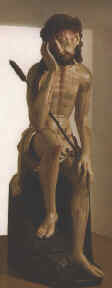 Christ in Misery, Cistercian Abbey
Christ in Misery, Cistercian Abbey
Lichtenthal, Germany, end of 15th century
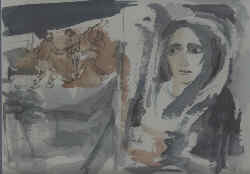 Scourging at the Pillar, Mater Dolorsa, Roxolana Luchakowski Armstrong, Contemporary
Scourging at the Pillar, Mater Dolorsa, Roxolana Luchakowski Armstrong, Contemporary
The Crowning with Thorns (Mark 15:17)
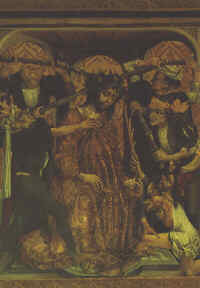 Wing Altar of the Bad Hersfeld Abbey Church (detail), Erfurt Master, ca. 1460-70, located in the Kassel State Collection of the Hessian National Museam
Wing Altar of the Bad Hersfeld Abbey Church (detail), Erfurt Master, ca. 1460-70, located in the Kassel State Collection of the Hessian National Museam
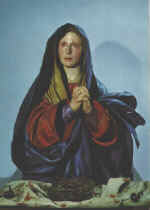 The "Soledad" of Mena, Mary contemplates the thorn crown
The "Soledad" of Mena, Mary contemplates the thorn crown
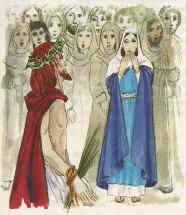 After the Judgment of Jesus, Rita Goodwill
After the Judgment of Jesus, Rita Goodwill
Published in The Life of Mary, Louis M. Savary, Regina Press A children's reflection.
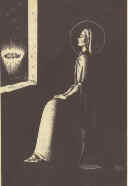 Contemporary Devotional, Artist Unknown
Contemporary Devotional, Artist Unknown
The reflection reads: Mary has seated herself, proudly erect, with all the dignity of a queen, as though she, too, crowned with mockery, were receiving the insults to the Holy Face of Jesus. Closed eyes speak of the inward vision of the awful humiliation of her divine son.
The Carrying of the Cross (John 19:17)
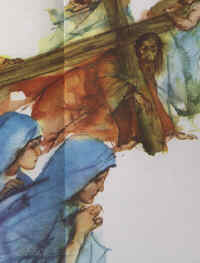 The Meeting, Fernando Saez, Published in La Virgen Maria Madre de Dios Barcelona and Madrid, 1977
The Meeting, Fernando Saez, Published in La Virgen Maria Madre de Dios Barcelona and Madrid, 1977
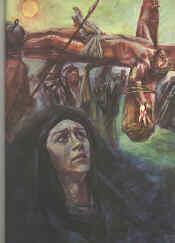 The Crucifixion, Di Giorgio Trevisan, Published in Maria di Nazaret Piero Bargellini Padova, 1978
The Crucifixion, Di Giorgio Trevisan, Published in Maria di Nazaret Piero Bargellini Padova, 1978
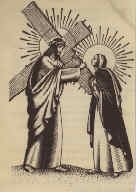 The Meeting, Contemporary Devotional, Artist Unknown
The Meeting, Contemporary Devotional, Artist Unknown
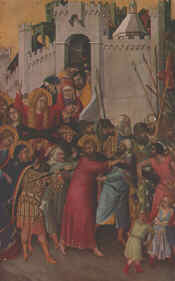 Christ Carrying the Cross, Simone Martini, 1285-1344, Sienese School, Mary is among the crowd left.
Christ Carrying the Cross, Simone Martini, 1285-1344, Sienese School, Mary is among the crowd left.
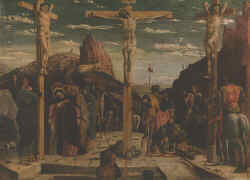 Calvary, Mantegna, ca. 1430-1506, North Italian School
Calvary, Mantegna, ca. 1430-1506, North Italian School
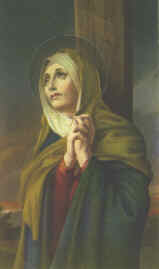 Mary's Contemplation, 20th century, Devotional
Mary's Contemplation, 20th century, Devotional
Extract: Mary, accept me as as a sharer in your sorrows and permit not that I should ever abandon the Cross, whereon your only begotten Son breathed forth his blessed spirit for my sake.
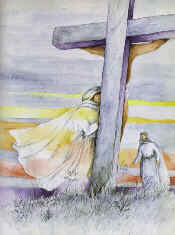 Mary's Reflection, Chung Hing, Published in Sur les chemins de Marie, Christiane Gaud, Editions MAME, Parish, 1987
Mary's Reflection, Chung Hing, Published in Sur les chemins de Marie, Christiane Gaud, Editions MAME, Parish, 1987
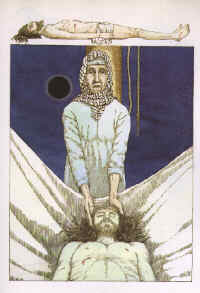 Pieta, Alfonso Ruano, Published in Maria Lene Mayer-Skumanz
Pieta, Alfonso Ruano, Published in Maria Lene Mayer-Skumanz
Translation to Italian from the German: Konstanze Szelényi and Roberto Graziotto
Editrice Elle Di Ci, Torino, 1989
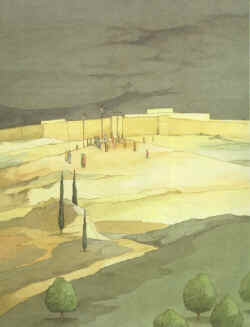 Crucifixion, Dorothée Duntze, Published in La Vie de Jésus, Les Grand Moments des Quartre Évangiles, Claude Plettner, et al Grain de Soleil, Éditions du Centurion, Paris, 1992.
Crucifixion, Dorothée Duntze, Published in La Vie de Jésus, Les Grand Moments des Quartre Évangiles, Claude Plettner, et al Grain de Soleil, Éditions du Centurion, Paris, 1992.
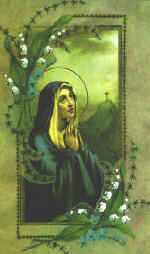 Early 20th century, German Devotional
Early 20th century, German Devotional
Week 3
"Standing by the cross of Jesus were his mother and his mother's sister, Mary the wife of Clopas, and Mary of Magdala." (John 19:25)
Follow Christ to the Cross
Liturgical Readings of the Season
Of the many heart-rending reflections presented by the Lenten liturgy this week, one aspect is prominent: Each human being is accountable! What we do, how we live, the choices we make are never left without consequence. Important for us is to own this accountability.
The first reading for the Roman Catholic liturgy of this week is taken from Chronicles 36:14-17, 19-23. The chronicler tells us of infidelity added to infidelity, even by those who are called to specially represent service to Yahweh. Nevertheless, Yahweh loves his loves his people and wishes to spare them. He sends them messenger after messenger.
But they ridiculed the messengers of God, they despised his words, they laughed at his prophets.... (2 Chronicles 36:16)
In the end, the people suffered the loss of their home, their beloved holy place, and their identity as a nation. (2 Chronicles 36:19-23) It is no wonder that the Psalmist laments:
Beside the streams of Babylon we sat and wept at the memory of Zion....
For we had been asked to sing to our captors,
to entertain those who had carried us off;
"Sing" they said "some hymns of Zion."
How could we sing one of Yahweh's hymns...?
Jerusalem, if I forget you, may my right hand wither!
In this darkness, a redeemer would come to take the people home, to release the captives and aid in the rebuilding of the sacred place. The second reading presented by the liturgy is Ephesians 2:4-16. The writer of Ephesians speaks of this redeemer, Jesus Christ:
Do not forget, I say, that you had no Christ and were excluded from membership of Israel, aliens with no part in the covenants with their Promise; you were immersed in this world, without hope and without God. But now in Christ Jesus, you that used to be so far apart from us have been brought very close, by the blood of Christ.
This is Yahweh's purpose: to bring us very close, close to God Yahweh and close to each other, accountable to each other and hence to the nation. The Scriptures tells us that we need grace in order for this "coming close" to take place:
But God loved us with so much love that he was generous with his mercy: when we were dead through our sins, he brought us to life with Christ--it is through grace that you have been saved--and raised us up with him and gave us a place with him in heave, in Christ Jesus.
This was to show for all ages to come, through his goodness towards us in Christ Jesus, how infinitely rich he is in grace. Because it is by grace that you have been saved, through faith; not by anything of your own, but by a gift from God; not by anything that you have done, so that nobody can claim the credit. We are God's work of art, created in Christ Jesus to live the good life as from the beginning he had meant us to live it. (Ephesians 2:4-10)
What does the liturgy present to us as Jesus' testimony? The Gospel discourse presents part of a dialogue between Nicodemus, a leader of the people, and Jesus. Jesus has chided Nicodemus for his lack of knowledge of God's purpose for the people. Jesus tells Nicodemus:
"Yes, God loved the world so much that he gave his only Son,
so that everyone who believes in him may not be lost
but may have eternal life.
For God sent his Son into the world not to condemn the world,
but so that through him the world might be saved.
No one who believes in him will be condemned. (John 3:16-18)
We are accountable ultimately to accept the invitation of grace, to believe in Christ Jesus, and to live and act out of this life of faith. It is a faith that is to be lived in the world and for the world, while at the same time remembering that there is death, a call to accountability and, finally, the hope of eternal life.
Follow Christ with Mary to the Cross
Liturgical Readings of the Season from the Votive Mass of the Lenten Season: The Blessed Virgin Mary at the Foot of the Cross II
In the previous two Lenten meditations, we discussed Mary as a woman of faith who followed Jesus from the first moment of his existence, to the cross, and beyond. Mary spoke her yes in faith, even though she did not know where it would lead. Today, we will see that her faithful yes led her to the foot of the cross. Mary was held accountable for her yes. She was given the grace of God to have the strength to do so. The most severe moment of reckoning was her loyal adherence to Jesus, even to the cross. By her presence at the cross she was allowed "to be a partner in his passion." Preface of the Mass, Mary at the Foot of the Cross II
The Opening Prayer of the Marian Liturgy states:
Lord our God,
you place at the side of your suffering Son
his mother to suffer with him,
so that the human race,
deceived by the wiles of the devil,
might become a new and resplendent creation.
Grant that your people may put aside their inheritance of sin
and put on the newness of life
won by Christ the Redeemer...
Mary was to stand at Jesus' side as Eve had stood at Adam's side. By Jesus' suffering, death and resurrection, new life was to be given to the world. As we pray in the Preface, Jesus established the family of the Church, a gift for the healing of the world.
Father, all-powerful and ever-living God,
we do well always and everywhere to give you thanks
through Jesus Christ our Lord.
In your divine wisdom
you planned the redemption of the human race
and decreed that the new Eve
should stand by the cross of the new Adam
as she became his mother
by the power of the Holy Spirit,
so, by a new gift of your love,
she was to be a partner in his passion,
and she who had given him birth
without the pains of childbirth
was to endure the greatest of pains
in bringing forth to new life
the family of your Church
The Gospel of the Marian Liturgy is John 19:25-27. We quote the first verse:
Standing by the cross of Jesus were his mother
and his mother's sister, Mary the wife of Clopas,
and Mary of Magdala.
The beloved disciple was there, too. Jesus alone died and redeemed! Yet, Jesus was not alone in his dying. Those who loved him were standing by, sharing as deeply as any can, the suffering of the Savior. They gave their yes, they remained with him. They were accountable and found faithful.
We pray with the Church:
Lord God,
protect your servants...
as we call to mind Mary's suffering with Christ,
grant that by carrying our cross each day
we may come to share in his resurrection,
for he lives and reigns for ever and ever. Amen
In carrying our cross, we show our accountability. We reveal God's grace as grace as gifted our lives.
Devotions Draw Us into Participation in Christ's Suffering
To carry the cross is a frequently-cited way to master life. We are to take up our cross and follow him. Spirituality speaks of three forms of the cross: the family cross, the professional cross, the personal cross. Another form of expression: the cross is the other who burdens me, but also me who burdens others. Inescapable. Always a two- or more way street.
Over the centuries, the Roman Catholic Church has developed a devotion which confronts the cross and challenges the individual to share in the Christ's way of the cross. Today, this devotion is called the Way of the Cross or Stations of the Cross.
The earliest roots of this devotion are thought to be traced to the practices of the early Christians at Jerusalem who visited and honored the holy places of Christ's passion. Some traditions assert that Mary visited the scenes of the passion daily. There is no evidence for this belief, but it is possible for us to speculate on Mary's devotedness to the places where her son suffered.
The first evidence of devotion to stations of Christ's passion are connected with the Crusades in the Middle Ages. Not only did the crusaders stop and venerate the places, but objects were transported to Europe that were thought to have been touched in some way by Christ. More notably, these objects were "reproduced."
By the sixteenth century and later, the devotion developed, for instance, of erecting a flight of stairs to commemorate those that Jesus walked at his judgment.
The Blessed Alvarez (d. 1420), on his return from the Holy Land, built a series of little chapels at the Dominican friary of Cordovea, in which, after the pattern of separate Stations, were painted the principal scenes of the Passion. About the same time the Blessed Eustochia, a Poor Clare, constructed a similar set of Stations in her convent at Messina. ... With regard to the number of Stations it is not at all easy to determine how this came to be fixed at fourteen. The Catholic E, Vol XV, 569-70
There is an account written in the fifteenth century that lists fourteen stations. It is thought that the devotion was largely promoted by the Franciscans and grew in popularity because of the specially-indulgenced blessings granted to those who prayed it. By the nineteenth and twentieth century, it was common for most parish churches to include a Way of the Cross in the main body of the church. The popularity of the devotion extended to places of pilgrimage where large outdoor stations were erected. In contemporary church buildings, the stations are often included in an alcove or chapel set aside for private prayer.
The traditional, best-known Stations of the Cross include three scenes which situate Mary at the Crucifixion:
The Fourth Station: Jesus meets Mary on the way to Calvary
The Twelfth Station: Mary stands near the cross
The Thirteenth Station: Jesus is taken from the cross and laid in the arms of His mother.
There are devotions which include Mary and the women at every station. Since this is a private devotion, the people are permitted to reflect on the passion of Christ in the manner that speaks to their own hearts.
Prayer
The faithful are encouraged to write their own Stations, to connect the various sufferings of their own lives with a reflection in some way on the continued sufferings of Christ. Just as each artist reflects on the passion and conveys a message of faith, so are each of us encouraged to reflect on the stations, to walk The Way, to convert and to remain accountable to the Lord who will one day return.
The Fourth Station: Jesus meets Mary on the way to Calvary
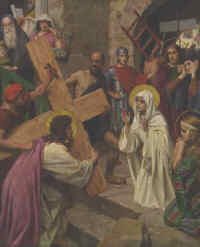 Mary Meeting Jesus, Jozaf Janssens
Mary Meeting Jesus, Jozaf Janssens
The Twelfth Station: Mary stands near the Cross
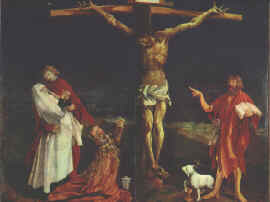 Christ on the Cross, Mathis (Gothardt) Neithardt, known as "Grünewald", 1512-1516
Christ on the Cross, Mathis (Gothardt) Neithardt, known as "Grünewald", 1512-1516
The Thirteenth Station: Jesus is taken from the Cross and laid in the arms of His mother:
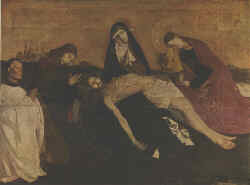 Villeneuve-les-Avignon Pietà, Unknown Artist, ca. 1460
Villeneuve-les-Avignon Pietà, Unknown Artist, ca. 1460
Week 4
"He said to his mother, Woman, behold, your son. Then he said to the disciple, Behold, your mother. And from that hour the disciple took her into his home." (John 19:26)
Follow Christ
Liturgical Readings of the Season
In this week's Scriptures, Jesus speaks of his hour that has come. Strangers in the land had heard of him and wished to see him. Jesus places things in perspective. It is not human fame that shall draw people to him. Public acclaim and honor is not what is important here. A entirely different motive will draw the people to him. Before this will happen, Jesus must die. In the following passage, he foretells his death and resurrection.
In the following reflection, the gospel passages are interspersed with psalm verses You are invited to hear Jesus and to respond with the psalm prayer.
Jesus speaks:
I tell you, most solemnly,
unless a wheat grain falls on the ground and dies,
it remains only a single grain;
but if it dies,
it yields a rich harvest. (John 12:24)
My answer:
Have mercy on me, O God, in your goodness,
in your great tenderness wipe away my faults;
wash me clean of my guilt,
purify me from my sin. Psalm 51:1
Jesus speaks:
It was for this very reason that I have come to this hour. (John 12:28)
My answer:
For I am well aware of my faults,
I have my sin constantly in mind,
having sinned against none other than you,
having done what you regard as wrong. (Psalm 51:2)
Jesus speaks:
And when I am lifted up from the earth,
I will draw the universe to myself. (John 12:32)
My answer:
Save me from death, God my savior,
and my tongue will acclaim your righteousness;
Lord, open my lips,
and my mouth will speak out your praise. (Psalm 51:3)
Follow Christ with Mary to the Commending
Liturgical Readings of the Season from the Votive Mass of the Lenten Season:
The Commending of the Blessed Virgin Mary
When Jesus was lifted up there was the small band at the foot of the cross. Scripture records the memory of the moment when Jesus drew to himself two persons who were to be particularly drawn into his redemptive act, Mary and the Beloved Disciple. The preface of the Mass, The Commending, sees the Beloved Disciple as a representative for all of those who follow the Lord.
At the foot of the cross of Jesus,
by his solemn and dying wish,
a deep bond of love is fashioned
between the Blessed Virgin Mary
and his faithful disciples:
the Mother of God is entrusted to the disciple
as their own mother,
and they receive her
as a precious inheritance from their Master.
She is to be for ever
the mother of those who believe,
and they will look to her
with great confidence in her unfailing protection.
She loves her Son in loving her children,
and in heeding what she says
they keep the words of their Master.
Mary and the disciple are the first of Christ's followers to be commended and commissioned. As the commentary for the fourth Marian Lenten Mass states: The Church sees the words of Jesus as a "special gift, by which Christ the Lord entrusted to his Virgin Mother all his disciples as her children (Leo XIII, Octobri mense: AAS 24 [1891-1892] 195)." The commentary continues:
It is primarily God who is glorified, for making "a home for the Blessed Virgin in the Church as the joyful mother of children" (Entrance Antiphon, cf to Psalm 113:9).
This act of commending is part of the mystery of Christ's passion and the Virgin's co-suffering; the liturgy therefore refers to the Blessed Virgin as one who "stood by the cross and tenderly looked on the wounds of her Son, whose death she knew would redeem the world" (Gospel Verse), and it places on her lips the words of the apostle: "I endure all for the sake of the elect, so that they too may achieve salvation in Christ Jesus with eternal glory" (Communion Antiphon, 2 Timothy 2:10)
Our Lady also was entrusted by Christ to the loving care of the beloved disciple: "To the virgin John, Christ, dying on the cross, entrusted his Virgin mother" (Liturgy of the Hours, 27 Dec, Antiphon 2 at morning prayer). In John Christ made all his disciples living signs of his own love for her.
Mary and John, then, are entrusted to each other, to love and care for one other. This is their commission. The very bond that binds them is not a bond only between two. It is a bond of the two to Jesus Christ, whose commission they fulfill. It remains Jesus who "draws all the universe to himself." He does this in the liturgy and in life! He draws us and sends us to the daily offering of our own lives, which shall be a magnet drawing all to Christ.
In the Marian liturgy, we pray:
Lord God,
let this sacred table increase our filial love,
for here we are nourished
by the body and blood of Christ,
who when dying on the cross
delivered his spirit into your hands
and entrusted us to his Virgin Mother as her children.
We ask this through Christ our Lord. Amen
Devotions Draw Us into Participation in Christ's Suffering
How can we let ourselves be drawn and draw? One way is to meditate and assimilate the Crucifixion Icon as it is expressed in this prayer:
Lord Jesus,
we gather in spirit at the foot of the Cross
with your Mother and the disciple whom you loved.
We ask your pardon for our sins
which are the cause of your death.
We thank you for remembering us
in that hour of salvation
and for giving us Mary as our Mother.
Holy Virgin,
take us under your protection
and open us to the action of the Holy Spirit.
Saint John,
obtain for us the grace of taking Mary
into our life, as you did,
and of assisting her in her mission. Amen.
May the Father and the Son and the Holy Spirit
be gloried in all places
through the Immaculate Virgin Mary. Amen
In the Calvary event, Mary and the beloved disciple both represent the Church, that is its original cell. Mary is the figure of Mother-Church; John stands for Christian discipleship. Together they personify faithful, loving and persevering commitment to the Church. They are both teachers of authentic ecclesial sensitivity. This Church of ours, at times, looks very human, beaten and broken. It is in dire need of all the friends it can get, dependent on faithful hearts and healing hands. Invited into the company of Mary and John, each part of the Church is called to be another healthy and life-giving cell of the Church. Each one of its members is graced with passionate and compassionate Marian sensitivity for the many needs and calls of Mother-Church.
The Three O'clock Prayer presents us with a whole array of themes. Mary is portrayed as the Mother of Jesus and, at the same time, as our mother, given to us by the very same Jesus hanging in agony on the Cross. Mary is depicted as the strong woman -- the holy virgin -- and lady of the mantle, whose protection we seek and need. She is the gentle mistress and sister, who opens our hearts and minds to the action of the Holy Spirit. Ever the fruitful mother, she forms those who are entrusted to her in the Spirit of her Son. As we take her into our life, she becomes a part of our self. Called into alliance with her, through whom the Holy Trinity shall be glorified in all places, we assist Mary in her mission as the Woman mandated by her Son.
Discipleship is thoroughly Marian, but it has a definite Johannine touch. The beloved disciple was told to take Mary into his home. More important still, he took her into his life and made her deepest memories of her Son his own. His heart was filled with her courage and faith. He shared her pain and loving certitude. He adopted her sense of mission and her total commitment to the spirit and work of her Son, his friend and spiritual master. Thus, the Three O'clock Prayer is a powerful lesson in Christian discipleship. It has its origin in Christ's crucified love, and takes shape and direction in his pressing invitation to take Mary into our life. Discipleship blossoms in the caring and creative company of Mary, the Mother and Woman. The figure of the beloved disciple is forever a reminder that the Church of Jesus Christ does not know members and partisans, but only disciples, daughters and son, and friends.
Week 5
"Brothers and Sisters: Whoever is in Christ is a new creation ... And all this is from God, who has reconciled us to himself through Christ and given us the ministry of reconciliation." (I Corinthians 5:17-18)
Follow Christ to Conversion and Reconciliation
Liturgical Readings of the Season
The Palm Sunday readings for the Roman Catholic Church draw us into the suffering of Christ. The Old Testament reading is taken from the songs of the suffering servant in Isaiah 50:4-7 and placed on the lips of Jesus, the suffering servant of his people:
The servant speaks:
The Lord Yahweh has given me
a disciple's tongue.
So that I may know how to reply to the wearied
he provides me with speech.
Each morning he wakes me to hear,
to listen like a disciple.
The Lord Yahweh has opened my ear.
For my part, I made no resistance,
neither did I turn away.
I offered my back to those who struck me,
my cheeks to those who tore at my beard;
I did not cover my face
against insult and spittle.
The Lord Yahweh comes to my help,
so that I am untouched by the insults.
So, too, I set my face like flint;
I know I shall not be shamed.
The Messiah must suffer. He must assume into Himself all human suffering to transform it and make sense out of it for an everlasting purpose. We live in the light of Resurrection. Our reading of the Scriptures is always on the backdrop of knowing that Jesus will overcome. Could it be that this knowledge makes us passive participants in the unfolding of an ancient drama? In our TV-violent age, are we immune to the real pain?
Perhaps we need to remember that real people suffered these events, not as actors on a stage, but as sons and mothers and relatives and friends. Jesus Christ alone suffered, died and redeemed us. He alone! He was truly alone yet not alone. Each person is ultimately alone in death. The words of Psalm 22, an ancient hymn of the sufferings and hope of the virtuous person, expresses the loneliness of the dying Christ:
My God, my God, why have you deserted me?
How far from saving me, the words I groan!
I call all day, my God, but you never answer,
all night long I call and cannot rest.
Yet, Holy One, you
who make your home in the praises of Israel,
in you our fathers put their trust,
they trusted and you rescued them ....
Yet here am I, now more worm than man,
scorn of mankind, jest of the people,
all who see me jeer at me,
they toss their heads and sneer,
"He relied on Yahweh, let Yahweh save him!
If Yahweh is his friend, let Him rescue him!"
Yet you drew me out of the womb,
you entrusted me to my mother's breasts;
placed on your lap from my birth,
from my mother's womb you have been my God.
Follow Christ with Mary to Conversion and Reconciliation
Liturgical Readings of the Season from the Votive Mass of the Lenten Season: The Blessed Virgin Mary, Mother of Reconciliation
Jesus was infinitely alone yet not alone. Mary, his mother was there and the small community of the beloved disciple and some women. (cf. John 19:25-27) This was the moment when Tradition holds it that the Church was born of the open wound of Christ on the cross.
But why all this? Clearly, to be reconciled with God! (cf. 2 Corinthians 5:20) In contemplating the utter misery of the God-man's suffering, we are invited to remember that we are to be washed clean and to share in the suffering. No one is spared the decision-making and the journey. No one is exempt from sin, sorrow, and misery, from the things that isolate and divide.
In Christ, the old things are to pass away, these things of sin. Saint Paul tell the Corinthians:
Brother and sisters:
Whoever is in Christ is a new creation:
the old things have passed away;
behold, new things have come.
And all this is from God,
who has reconciled us to himself through Christ
and given us the ministry of reconciliation, ...
So we are ambassadors for Christ,
as if God were appealing through us.
We implore you on behalf of Christ,
be reconciled to God.
For our sake God made Christ to be sin who did not know sin, so that in Christ we might become the righteousness of God.
The liturgy asks us to become persons of reconciliation. The introduction to the Marian liturgy states:
The Church has with ever greater clarity acknowledged the role of our Lady in reconciling sinners with God. The Fathers of the Church in the early centuries, in discussing the mystery of the incarnation of the Word, speak frequently of the virginal womb of the mother of the Lord as the place where 'peace' between God and the human race came to be.
Popular devotion has long remembered this 'peace' of Mary, the woman who gave birth to the Redeemer. She held him in her arms at his birth; tradition has it that he was placed in her arms at his death. She is reconciled to the Father's will. As time went on, Mary was called a refuge where the miserable could find consolation. Not only is she called Mother of Reconciliation. She is also called Refuge of Sinners. The sinner and the miserable find refuge in her peace.
Devotions Draw Us into Participation in Christ's Suffering
As early as the eleventh and twelfth century, we reference to Mary compassion toward the sinner. Saint Anselm of Canterbury (+1109) composed prayers and meditations which include the consideration of Mary's compassion. Legends abound which show Mary's love for those in trouble, especially for sinners in trouble. As shown in the images on this webpage, the earliest painting to express Mary's compassion were those where Jesus is taken from the cross and placed in the tomb. The placing in the tomb became the most important image. A later development of this theme is known to us as the Pietà.
In the fourteenth century an illuminated manuscript about the fall and redemption was written in Latin prosaic rhyme. It consists of one hundred lines and four miniature paintings. The manuscript bears the title, Speculum Humanae Salvationis (Mirror of Humanity's Salvation). Over time, the Speculum was extended to forty-five chapters, 4924 lines, and 192 miniatures. It contained three hundred quotes from Scripture and ancient writings. The last part dealt with the seven sufferings of Christ and the seven joys and seven sorrows of Mary. Mary is portrayed as a helper in the work of redemption. It is Jesus, however, who is central. This work received a great reception in writing, architecture and art between the fourteenth and sixteenth centuries. It is also in some of these manuscripts that the Pietà became a favored devotional image.
The theme continues today. Many artists, well known to the contemporary world, have tried to represent this moment of exquisite sorrow, abandonment, and at the same time intimacy of Son and mother.
Prayer
Plaint of the Madonna
Jacopone da Todi (+1306)
O Son, your soul has left you,
O Son of discouragement,
O Son of disappearance,
O Son who was poisoned!
O Son bathed in red and white,
O Son without compare,
O Son, to whom shall I turn?
O Son, you have left me!
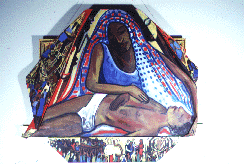 The Pietà of South Africa, Malaika Favorite, Oil on canvas, 1991
The Pietà of South Africa, Malaika Favorite, Oil on canvas, 1991
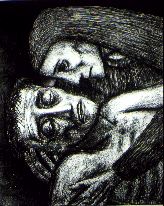 Michael Ciry, Etching, 1950, Cincinnati Art Museum, Sloniker Collection
Michael Ciry, Etching, 1950, Cincinnati Art Museum, Sloniker Collection
Lord our God, through the precious blood of Your Son You reconciled the world to Yourself and at the foot of his cross you chose the Blessed Virgin Mary to be the mother of reconciliation for sinners; grant through her intercession that we may obtain pardon for our sins. We make our prayer through our Lord Jesus Christ...
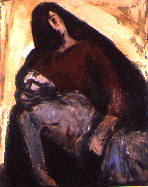 Roman Turovsky, USA, 1990
Roman Turovsky, USA, 1990
All About Mary includes a variety of content, much of which reflects the expertise, interpretations and opinions of the individual authors and not necessarily of the Marian Library or the University of Dayton. Please share feedback or suggestions with marianlibrary@udayton.edu.
